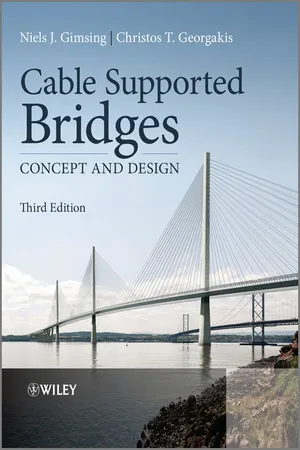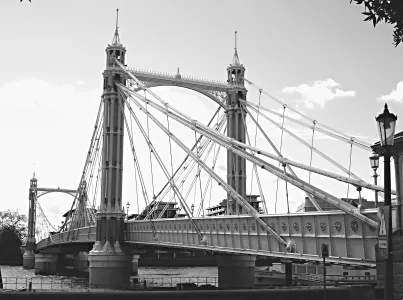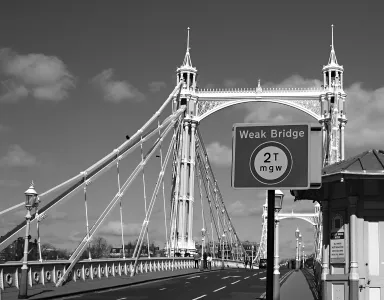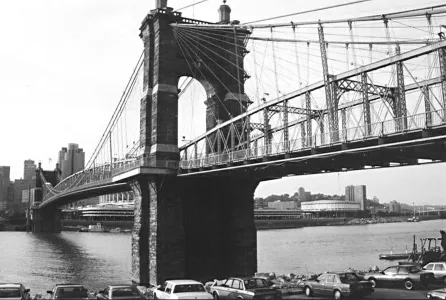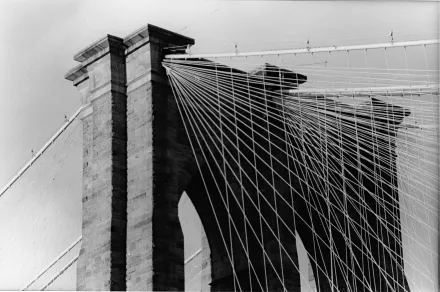![]()
Chapter 1
Evolution of Cable Supported Bridges
The principle of carrying loads by suspending a rope, chain or cable across an obstacle has been known since ancient times. However, it was not until 1823 that the first permanent bridge supported by cables composed of drawn iron wires was built in Geneva by the Frenchman Marc Seguin, one of five brothers who, in the following two decades, built hundreds of suspension bridges around Europe. All of these bridges were of modest size but they marked an important step on the way to the more impressive structures that followed.
The application of thin wires in the main load-carrying elements gave rise to a number of problems especially in relation to durability, as an efficient method for corrosion protection had not been found at that time. Therefore, some of the leading engineers preferred to construct suspension bridges with the main load-carrying elements, the catenaries, composed of pin-connected eye-bars forming huge chains.
This principle was applied by the British engineer Thomas Telford in the world's first bridge to cross a strait used by ocean-going vessels, the Menai Bridge between the British mainland and the Isle of Anglesey (Figure 1.1). Opened to traffic in 1826, this bridge had its 176 m long main span supported by chains assembled from wrought iron eye-bars, each with a length of 2.9 m.
The chain support was generally preferred by the British engineers of the nineteenth century and a number of notable bridges were built, among these the famous Clifton Suspension Bridge, initially designed by Isambard Kingdom Brunel, but not actually constructed until after his death. The bridge was opened to traffic in 1864 and it comprised a main span of 214 m – an impressive span, considering that the strength-to-density ratio of the wrought steel in the chains was less than one-fifth of the ratio of modern cable steel (Figure 1.2).
To erect the eye-bar chains, a temporary footway had to be established between the supporting points on the pylon tops and at the anchor blocks. In the case of the Clifton Suspension Bridge, this temporary footway was supported by wire ropes, so the principle of cable support was actually applied, although only in the construction phase.
A most unusual bridge based on application of eye-bar chains is the Albert Bridge across the Thames in London (Figure 1.3). The bridge was built from 1871 to 1873 and it is characterized by combining the cable stayed and the suspension system. A part of the deck load is transferred to the strong top chain through hangers and the rest is carried by a number of straight chains radiating from the pylon tops. The system is statically indeterminate to such a degree that it was impossible with the available tools to calculate forces and moments to get even close to the exact values. Nevertheless the bridge with its 122 m-long main span is still in service although there are restrictions on the traffic allowed to pass over it (Figure 1.4).
Chain support was also applied in a number of bridges on the European continent, but here it was to a larger extent in competition with cable supported suspension bridges. Thus the longest free span in Europe was for several decades found in the wire supported Grand Pont Suspendu across the Sarine Valley at Fribourg in Switzerland. The bridge was completed in 1834 and it had a main span of 273 m. In the Grand Pont Suspendu, each of the four main cables was composed of over 1000 wires, grouped in 20 strands, each assembled on the ground and lifted individually into position. The bridge was in service for almost a century until it was finally demolished in 1923.
On a global level, the Swiss span record was beaten in 1849 by the completion of the Wheeling Suspension Bridge across the Ohio River in the USA. This bridge had a main span of 308 m, carried by a total of 12 parallel-wire cables, six on either side of the roadway.
The Wheeling Bridge is still in existence, although not in its original version. Five years after its completion, in 1854, a violent gale blew the bridge down. Subsequently it was reconstructed and later, in 1872, further strengthened by a fan-shaped system of stays. The principle of strengthening the suspension system with stays was originally introduced during the construction of the suspension bridge across the Niagara Gorge. This bridge was designed by the famous bridge designer John A. Roebling, who was born in Germany but emigrated to the United States of America at the age of 25. The Niagara Bridge was constructed in the period from 1851 to 1855 and it was the first major suspension bridge to have air-spun wire cables, a system invented by Roebling.
The span of the Niagara Bridge was not quite as long as for the largest suspension bridges of that time but, due to the fact that the bridge carried both a railroad track and a roadway, its span of 250 m was still a very impressive achievement. As a most unusual feature the truss of the Niagara Bridge had the railroad track on the upper deck and the roadway on the lower, inside the two trusses.
Another unusual feature of the Niagara Bridge was the use of wood in the truss. This might today seem to be an awkward combination of structural materials but it must be remembered that in the early days of railroad building in North America, wood was the preferred material for bridges across rivers and gorges. For the Niagara Bridge, the application of a wooden truss resulted in a relatively short lifespan as the bridge had to be replaced in 1897 after 42 years of service.
The largest of Roebling's bridges completed during his lifetime, the Cincinnati–Covington Bridge across the Ohio River, was completed in 1866 with a record-breaking span of 322 m (Figure 1.5). In this bridge he tested many advanced features before they were adopted in his most sublime achievement: the design for the Brooklyn Bridge across the East River in New York.
Brooklyn Bridge
The Brooklyn Bridge across the East River between Manhattan and Long Island (Figure 1.6) is justifiably regarded as the ancestor of all modem suspension bridges and it was to a large degree detailed by Roebling before his death in 1869 shortly after the start of construction of this, the greatest bridge of his career. Opened to traffic in 1883, the Brooklyn Bridge had a centre span of almost 500 m (486 m) and side spans of 286 m, i.e. a total cable supported length of 1058 m.
Based on his experience during design and construction of several suspension bridges, and through his investigations into accidents such as the collapse of the Wheeling Bridge in 1854, Roebling had acquired a profound understanding of the aerodynamic problem. This is clearly indicated in his own description of the Brooklyn Bridge concept:
But my system of construction differs radically from that formerly practised, and I have planned the East River Bridge [as the Brooklyn Bridge was initially called] with a special view to fully meet the destructive forces of a severe gale. It is the same reason that, in my calculation of the requisite supporting strength so large a proportion has been assigned to the stays in place of cables.
This description proves that Roebling knew very well that a cable stayed system is stiffer than the suspension system, and the fact that the stays of the Brooklyn Bridge carry a considerable part of the load can be detected by the configuration of the main cable having a smaller curvature in the regions where the stays carry a part of the permanent load than in the central region, where all load is carried exclusively by the main cable.
The efficiency of the stay cables (Figure 1.7) is clearly demonstrated by the following remark by Roebling: ‘The supporting power of the stays alone will be 15 000 tons; ample to hold up the floor. If the cables were removed, the bridge would sink in the center but would not fall.’
Roebling had started his engineering career at a time when the design of bridges was still more of an art, requiring intuition and vision, than a science. Therefore, he had to acquire a profound understanding of the structural behaviour of cable supported bridges through observations and by experience. He gradually learned how to...
